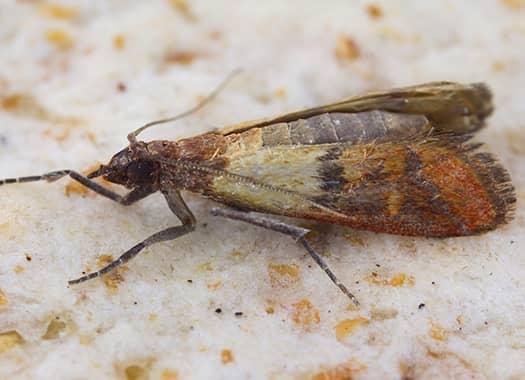Five Minutes With Sprague Regional Entomologist Ashley Roden, B.C.E.
A stored product pest infestation is no picnic for QA or facility managers. An active infestation in a grain mill, food processing plant, bulk storage facility or grocery store can result in spoiled products, lost production time and sales, weakened customer confidence in your brand, and less than satisfactory third-party audit results.
An infestation can also result in costly product recalls and additional unbudgeted expenses to replace spoiled products, deep cleaning of equipment, and additional pest management services to remediate the problem.
Know Your Adversary
The first step to preventing a stored product pest problem – or any pest issue for that matter – from spiraling out of control is to make a proper identification. Failure to do so can result in pest management programs that do not deliver the intended result – preventing or eliminating stored product pests.
Ashley Roden, B.C.E., regional entomologist with Sprague Pest Solutions, said stored product pests can be tricky to identify if you don’t know what you’re looking at.

Sprague regional entomologist Ashley Roden, B.C.E. said stored product pests can be tricky to identify if you don’t know what you’re looking at.
“Stored product pests can be a lot of little brown beetles or moths with similar names that at first glance look similar but don’t act alike,” said Roden. “There is more to stored product pests than meets the eye.”
For example, you have the Indian meal moth and the meal moth. The names are similar, but the behaviors are not. Indian meal moths prefer to eat fresh food products while meal moths are less discerning when it comes to their menu choices and will attack older, spoiled food products.
Insect Life Stages Tell the Story
By the time a client notices a stored product pest on the outside of a pallet of dog food inside their facility the damage may already be done.
Roden said adult stored product pests look completely different from their larval or pupal stage.
“Seeing one adult is not necessarily a sign of an infestation but noticing pests in the larval or pupal stage can be cause for concern,” added Roden.
Some stored product pests undergo a complete metamorphosis, and it is during the larval stage where most of the consumption and spoilage of food product is done.
Drugstore and cigarette beetles can complete their entire life cycle inside food products such a dry dog food or pasta. They will only announce their presence when they breakout of the packaging as adults and fly around.
Again, seeing one adult doesn’t mean your facility is inundated with stored product pests but seeing several could mean they are reproducing and that is a problem.
Where Are Stored Product Pests Found?
Once stored product pests gain access to a food processing facility they are most likely found in or near processed and unprocessed food like rice, flour, grains, etc. or where there is food spillage and dust. This can include at the feet or under food processing equipment, on top of exposed pipes and beams, and inside electrical boxes or machine housing. Any place where food or food dust is found can attract stored product pests.
Flour and feed mills, dry pet food, pasta and powdered milk processing facilities, or breweries are among the most vulnerable food processing facilities to a stored product pest infestation.
Have A Plan to Deal With Stored Product Pests
Many stored product pests are strong fliers and can threaten facilities from neighboring properties by taking advantage of open loading dock doors or windows and ventilation openings with missing screens. They can also ‘Trojan horse’ their way inside a facility in incoming shipments.
If clients suspect they have a problem with stored product pests, they should call their pest management service provider to come out and conduct a thorough inspection. If clients can capture a sample or send a photo of the insect in question, it will help expedite the identification process and arrive a solution to the problem sooner.
Clients should segregate suspected infested product away from other products. Identify a ‘quarantine’ zone inside or outside your facility where suspected product can be stored. And don’t be afraid to reject a shipment that shows signs of pest activity. Remember, once stored product pests make their way inside, they are more difficult and costly to remove.
For more information on how Sprague Pest Solutions can assist you create and deliver an effective stored product pest prevention program for your commercial facility, call 855.805.0755.

